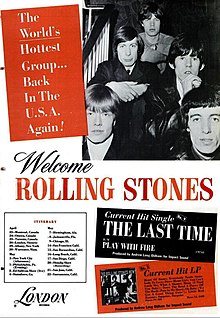The album was recorded at Chess Studios in Chicago and RCA Studios in Los Angeles. In January and February that year the band played 34 shows for around 100,000 people in Australia and New Zealand. The single "The Last Time", released in February, was the first Jagger/Richards composition to reach No. 1 on the UK charts; it reached No. 9 in the US. It was later identified by Richards as "the bridge into thinking about writing for the Stones. It gave us a level of confidence; a pathway of how to do it."
Their first international No. 1 hit was "(I Can't Get No) Satisfaction", recorded in May 1965 during the band's third North American tour. Richards recorded the guitar riff that drives the song with a fuzzbox as a scratch track to guide a horn section. Nevertheless, the final cut was without the planned horn overdubs. Issued in the summer of 1965, it was their fourth UK No. 1 and their first in the US where it spent four weeks at the top of the Billboard Hot 100. It was a worldwide commercial success for the band. The US version of the LP Out of Our Heads, released in July 1965, also went to No 1; it included seven original songs, three Jagger/Richards numbers and four credited to Nanker Phelge. Their second international No. 1 single "Get Off of My Cloud" was released in the autumn of 1965, followed by another US-only LP, December's Children.
The album Aftermath, released in the late spring of 1966, was the first LP to be composed entirely of Jagger/Richards songs; it reached No. 1 in the UK and No. 2 in the US. On this album Jones' contributions expanded beyond guitar and harmonica. To the Middle Eastern-influenced "Paint It, Black" he added sitar; to the ballad "Lady Jane" he added dulcimer and to "Under My Thumb" he added marimbas. Aftermath also contained "Goin' Home", a nearly 12-minute-long song that included elements of jamming and improvisation.

Niciun comentariu:
Trimiteți un comentariu